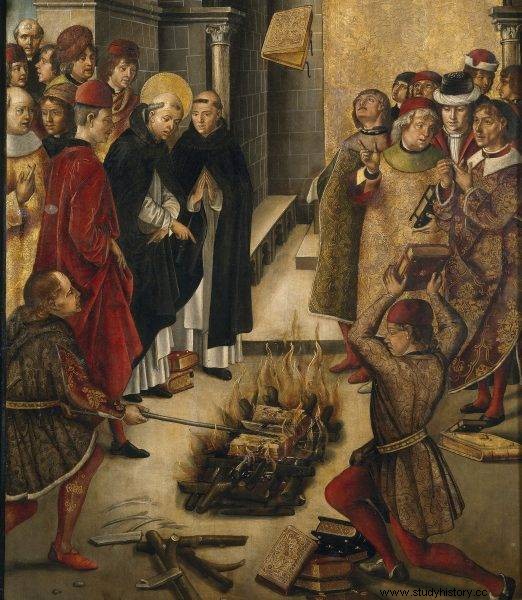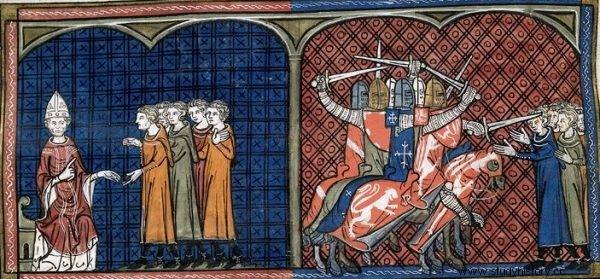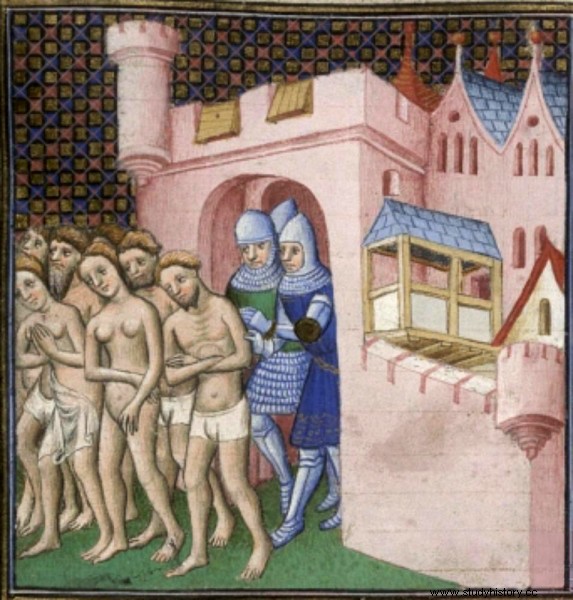According to Pope Innocent III, the greatest threat to Christianity were all heretics. And the worst of them were the Cathars.
When in 1095 Pope Urban II called on the Christian world to recapture the Holy Land from the hands of the infidels, he could not have known that he would thereby create a huge problem for the Catholic Church. And it is not about the involvement of European knights in an armed conflict with the Muslim world. The much less obvious side effect of the Crusades was bringing to the very center of Europe an element that could destroy the Church from within . This threat was the heretics, and more specifically the Cathars.
Thanks to the protectorate of local princes, they began to gain more and more supporters in southern France. The system of values they presented has become an alternative to the teachings of the Holy See. For Rome, the Cathars turned out to be an extremely formidable enemy that had to be eliminated as soon as possible. To find out why they were such a threat to Christianity as they ended up in the south of France, and what made them so popular, first go to the medieval ... Byzantium.
East to West
It's hard to know exactly when Catharism was born. What we do know is that he was strongly associated with the Middle Eastern dualistic movements such as Manichaeism and Gnosticism. Simply put, the basic premise of this type of religious system was the belief in the existence of two equal gods. The first was responsible for the spiritual world and represented good. The second was the creator of the material world and was responsible for the existence of evil.
On the basis of Manichaeism, other dualistic sects evolved in south-eastern Europe in the following centuries. The most popular were Paulicians and bogomils (also called bogomiłami or bogomilców). The latter were particularly important for the development of heretical movements in Europe. At the beginning of the 10th century, they found a mass of followers in recently Christianized Bulgaria. At the end of the century, it was the target of the conquest of the Byzantine ruler Basil II. In the Battle of Klidion in 1014, he defeated Bulgarian forces and brought the country under the influence of the Eastern Roman Empire.

The Cathars believed that the creator of the material world is not God, but Satan, the Church is a corrupt and unnecessary institution, and all sacraments are unnecessary.
This ruler, later known as Basil II Bulgaricide, caused that to the capital of his empire began to arrive Bogomili living in Bulgaria until now. According to the chronicles, at the end of the 11th century, they became quite a significant force in Byzantium. . Fate wished that the process of popularizing the dualistic movements in the capital of the Eastern Roman Empire took place in the years when Christians remembered the Holy Land and began to make preparations for the recapture of Jerusalem from the hands of Muslims. During the crusades, the bogomili broke away from their Bulgarian roots, and then began to carry out a lively missionary activity . They are called Cathars (from Ancient Greek katharoi - "Cleans") together with the knights returning from the crusades, they went to Western Europe. Most of them settled in southwestern France in a region known as Languedoc.
Guests, guests
Languedoc in the 12th century was quite a rich land and was part of the French county of Toulouse. The rulers of this region, although they were officially the supporters of the French king, pursued a very independent internal and external policy. The Cathar teachings spreading out into the provinces, as they had been in Byzantium, began to gain more and more popularity. They found their followers both among the local aristocracy and the common people.
Meanwhile, increasingly loud voices about the activities of heretics in Languedoc began to reach the church authorities. Rome was doubly concerned about this turn of events because the ideas they presented were turning the theological foundations of the Catholic Church upside down . The Cathars believed that the creator of the material world is not God but Satan , The Church is a corrupt and unnecessary institution, and all sacraments are unnecessary.
During the Third Lateran Council in 1179 it was decided to excommunicate the Cathars and their protectors . The greatest impetus to fight heresy in France came from Innocent III, elected Pope in 1198. Initially, he only ordered to intensify missionary activity in Languedoc, to hold talks with the Cathars and convert them to Catholicism. These measures have had poor results. Cities such as Carcassonne, Beziers and Albi began to turn into centers of Qatari ideology. From the name of the latter, Cathar town came to be called Albigenses.
In the name of God
When on January 15, 1208, the knights of Raymond VI, Count of Toulouse and protector of the Cathars killed the papal legate Peter de Castelnau, Innocent III decided to bring the heaviest cannons. That same year, announced the need to organize a crusade against the Qatar heretics of Languedoc . In 1208 he wrote:
On then, soldiers of Christ! Hurry up, brave recruits to the Christian army! Let the universal cry of sorrows of the Holy Church tear you to your feet, let you be filled with pious zeal to avenge the monstrous crime committed against your God . Attack the heresy with more than the Saracens , because they are the greater evil, hitting with a strong hand and an outstretched shoulder.

Innocent III announced the need to organize a crusade against the Cathar heretics of the Languedoc.
Interestingly, this cry was initially completely ignored by King Philip II of France. First, he believed that a holy war against heresy was less important than maintaining good relations with his vassal, Count Raymond VI of Toulouse. Secondly, he was aware of the anti-French alliance between King John without Land and the Holy Roman Emperor Otto IV. Therefore, he preferred not to get involved in this risky religious enterprise.
Crusade against the Cathars
After more than twenty years, the kings of France will ultimately be the biggest winners in the fight against the Cathars. But before that happens, Languedoc will witness many bloody fights. The Roman curia promised not only a plenary indulgence of sins to everyone who would take part in the crusade , but also the possibility of seizing the goods of heretics. The latter encouragement was much more attractive to the knights. In early July 1209, the army of knights, mercenaries and pilgrims left Lyon. She went to Languedoc to convert recalcitrant Albigenses with fire and sword. At the head of the army was Szymon de Monfort, a French knight then considered one of the best military commanders.
When the news of the impending crusade reached the Count of Toulouse, he immediately changed front and officially supported the idea of fighting the Cathars. In the future, Raymond VI will skillfully maneuver between the parties, once supporting the Church and sometimes heretics . Not all vassals of the Count of Toulouse showed such a tendency to quickly change their minds. The Christian army headed towards the town of Beziers, whose inhabitants stood firm and supported heretical ideas. This is where the most tragic act of the crusade took place.
God will know his own
Arnaud Amaury was a papal legate. He was chosen by Rome to oversee and report on the progress of the Christian army in Languedoc. When on July 22, 1209, she captured the city of Beziers, he wrote the following to Innocent III: " Our people did not spare anyone, regardless of their rank, sex or age and put almost 20,000 people on the sword. After this great slaughter, the whole city was looted and burned down while divine revenge was miraculously raging against it. "

Expulsion of the Cathars from Carcassone
Earlier, Bishop Beziers tried to prevent bloodshed and negotiated with the crusaders. He returned to town with the message that it would be spared if the townspeople gave up all the Cathars living there . The Bezires community, however, rejected these demands, which ultimately sealed its fate. When Christian troops broke through the city walls, the slaughter began. Knights raged in the streets, killing, raping and looting . A large part of the inhabitants took refuge in the cathedral of St. Mary Magdalene, thinking that the walls of the temple would keep them safe. However, when the crusaders broke through the doors of the church, they murdered everyone gathered inside.
It is believed that before the storming of the city, the papal legate was asked how to distinguish a heretic from a Christian, should it be necessary to kill one of them. Arnaud Amaury would then say the famous words: Kill them all. God will recognize his own. "
Bloody face of the Church
The number of 20 thousand victims of the Beziers massacre is greatly exaggerated, because the population of the entire city at that time numbered several thousand inhabitants. Nevertheless, the bestiality of Christians was so great that the slaughter in Beziers became forever a symbol of the bloody face of the medieval Church . Hearing about the fate of the city, some of the besieged centers, for fear of sharing the fate of Beziers, surrendered without a fight and opened their gates to the papal army. The fate of the Cathars living there was very different. Some were forced to wear white robes with a yellow cross painted in the center. Some have been banished. Some people have renounced their faith and converted to Catholicism. Still others in the old Christian custom were burned at the stake.
Where Two Fight
After the initial successes of the Christian army, the fighting in Languedoc became more balanced. The turning point of the campaign was the siege of Toulouse in 1218, during which the crusade commander Szymon de Monfort was killed (he was hit in the head by a catapult). Without command, the Christian army lost momentum. The forces favoring the Cathars began to regain control of other cities.

When it seemed that Languedoc would be a field of devastating battles for a long time, the kings of France stepped in.
When it seemed that Languedoc would become a field of devastating battles for a long time, those who had so far remained aloof - the kings of France - entered the action. At the beginning of 1226, Louis VIII began the royal expedition to the Cathars. Later, his son, Ludwik IX, who was then under age, continued the fighting. The French crown finally saw an interest in joining the crusade. Thanks to this, she was able to regain complete control of the county of Toulouse. After a series of victorious skirmishes, the royal forces captured the capital of the region and the count Raymond VII (son of Raymond VI), supporting the Cathars, was offered peace. Under the Treaty of Paris of April 12, 1229, the crusade against the Albigenses ended . Raymond VII was allowed to retain power in the county for life, but after his death, his lands would become part of the estate of the King of France.
The most important thing, however, was what was to happen to the Cathars in Languedoc. The entire authority in the county in the discretion of searching, interrogating and punishing the Cathars had an institution that in the following centuries will become a real terror for all of Europe - the papal inquisition. The war between Rome and the Albigenses laid the foundations for the future power of Sanctum Officium . The fight against heresy became so important to the Holy See that in 1234 Pope Gregory IX changed the rules of the Inquisition and gave it a much more important rank . The effectiveness of the reform is demonstrated by the fact that over the next several decades the inquisitors have eradicated the remnants of heretical movements from Languedoc. The last Qatari "cleric" Peire Autier was burned at the stake in 1310.
